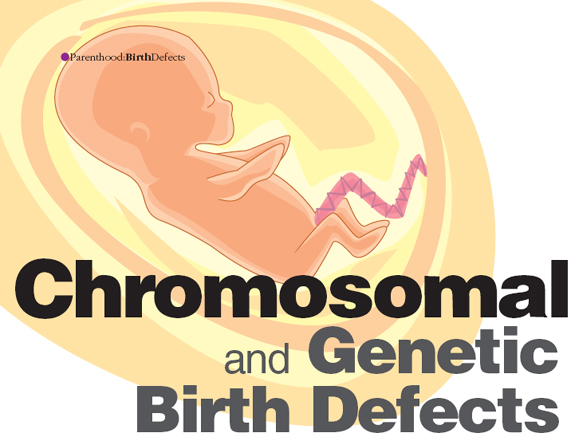Birth defects are the leading cause of death among babies in their first year of life. Nevertheless, there are steps that you can take to prevent, if not prepare yourself to cope with, certain birth defects that stem from genetic factors.
The Risk Factors
Birth defects are abnormalities in baby’s physical structure, function or metabolism that are present at birth and which may result in physical or mental disability, and even death. The majority of birth defects have either no apparent cause or a combination of genetic (or hereditary), non-genetic and environmental causes. The risk factors include:
- Maternal age at the time of conception (the risk of birth defects increases after the age of 35).
- Defects or disorders in the parents’ genes.
- Maternal diseases (such as diabetes and heart disease).
- Infections passed from mother to baby (such as rubella or toxoplasmosis, a parasitic infection from contact with cat faeces).
- Certain medications taken by the mother.
- Drug and alcohol abuse by the mother.
- Cigarette smoking.
- Mother’s exposure to agents known to cause birth defects (eg methyl mercury, lead and radiation).
While it’s hard to be absolutely certain whether you are at risk of giving birth to a baby with birth defects, your doctor would want to help you identify the presence of any of the known risk factors. He will ‘interview’ you about your lifestyle, medical history, family history of chronic diseases and so on. It is crucial that you answer as accurately and completely as possible.
Birth Defects Due To Your Genes
There are two genetic causes of birth defects – (1) abnormalities in the number or structure of chromosomes that make up your genes and (2) defects in a single gene you carry. In addition, genetic disorders can sometimes result from spontaneous mutation that may happen to the egg or sperm – after fertilisation.
What Are Chromosomal Abnormalities?
Chromosomes, which carry genetic information, are rod-shaped structures located in the centre (nucleus) of every cell in the body. A normal human cell contains 46 chromosomes, arranged in pairs. Some common chromosomal abnormalities include:
- Down syndrome (trisomy 21). This is a common chromosomal disorder. Children with Down syndrome have an extra number 21 chromosome instead of the normal two. Children with Down syndrome have a distinct facial appearance (with small head, flat face and upward-slanting eyes) and various degrees of physical problems and mental retardation.
- Trisomy 18 and 13. Children with this disorder have three number 18 chromosomes (Edward Syndrome). A less common condition is having three number 13 chromosomes (a condition called Trisomy 13 or Patau Syndrome). Both disorders severely affect physical and mental development and affected infants rarely live more than two years. These are lethal chromosomal abnormalities and most babies die during pregnancy, some after birth.
- Sex chromosome disorder. This occurs when baby is born with an extra or missing sex (X or Y) chromosome. Some of these conditions may cause varying degrees of disabilities in learning, behaviour and fertility.
What About Single Gene Disorders?
Genes are the DNA molecules that determine the characteristics baby will inherit from his parents. Genes are located at specific places (like beans in a pod) on a chromosome and always occur in pairs, one from the father and another from the mother. There are three types of single gene disorders:
- Recessive gene disorders. These occur when each parent contributes an altered gene, thus making both genes in the pair abnormal. Specific ethnic groups are at significantly greater risk of having certain recessive disorders. If you or your husband has a family history of a recessive genetic disorder, you both need to take a blood test to check whether you could be carriers of that disorder. If both you and your husband are carriers, the inheritance risk can be calculated and you may be advised to take special tests during your pregnancy such as amniocentesis or CVS (chorionic villus sampling) to ascertain whether your foetus is affected.
Thalassaemia is a common recessive disorder found among people from Southeast Asian and Mediterranean countries. It affects the blood, making the red blood cells unable to carry sufficient oxygen for the body’s needs. A child with thalassaemia major (one of the types) usually dies between ages 1 and 8, if untreated.Young couples with a family history of thalassaemia are encouraged to be screened for thalassaemia before deciding to have children. Both parents have to be thalassaemia carriers (or have thalassaemia traits) to have a 25% risk of having a baby with thalassaemia major in every pregnancy.
- Dominant gene disorders occur when only one gene in the pair is altered. However, it overrides the other – normal – one. A baby can either inherit a dominant gene disorder from a parent (the chances stand at 50%) or develop a dominant gene disorder on his own (due to a mutation in his genes, his mother’s egg or father’s sperm).
Achondroplasia is a rare skeletal condition resulting in short arms and legs. It results from a dominant gene disorder arising from mutation of the father’s sperm due to advanced age. Huntington’s chorea (Huntington’s disease) is another example of a dominant gene disorder. This degenerative condition causes movement problems and increased senility beginning in adulthood.
- X-linked gene disorders. Normal males have one X and one Y chromosome, and normal females have two X chromosomes. X linked disorders involve an altered gene on the X chromosome and may be either recessive or dominant.
Haemophilia and Fragile X are examples of X-linked recessive gene disorders. These are generally passed from normal women carriers to their affected male babies. Female babies can be carriers but usually do not have any symptoms of the disorder. If you, the mother, are a carrier of an X-linked recessive gene disorder, each of your sons will have a one-in-two chance of being affected, and each of your daughters will have a one in two chance of being a carrier. X-linked dominant conditions are less common conditions in which an altered gene on one X chromosome is sufficient to cause symptoms (even though the other X chromosome is normal). In this type of inheritance, a woman can pass the condition to her sons or daughters, and a man can only pass it to his daughter.
Reduce The Risk Of Birth Defects
Parents need to be aware of the presence of chromosomal and/or genetic birth defects in their own parents, siblings and extended families. By informing your doctor before becoming pregnant or early in your pregnancy, tests can be performed to ascertain baby’s risk of inheriting those defects. Other than that, you can both take steps to minimise the non-genetic and environmental risk factors that may cause mutation of your egg, sperm or baby’s genes as well.
- Lead a healthy lifestyle always, starting from before you become pregnant
- Avoid recreational drugs, smoking and alcohol, especially during your pregnancy
- Minimise or avoid exposure to any known pollutants (eg lead), radiation and harmful chemicals
- Always check with your doctor before taking nutritional supplements
- Do not take medications on your own that, under normal circumstances, require a doctor’s prescription
- Ask your doctor which over-the counter medications are to be avoided during pregnancy







Comments